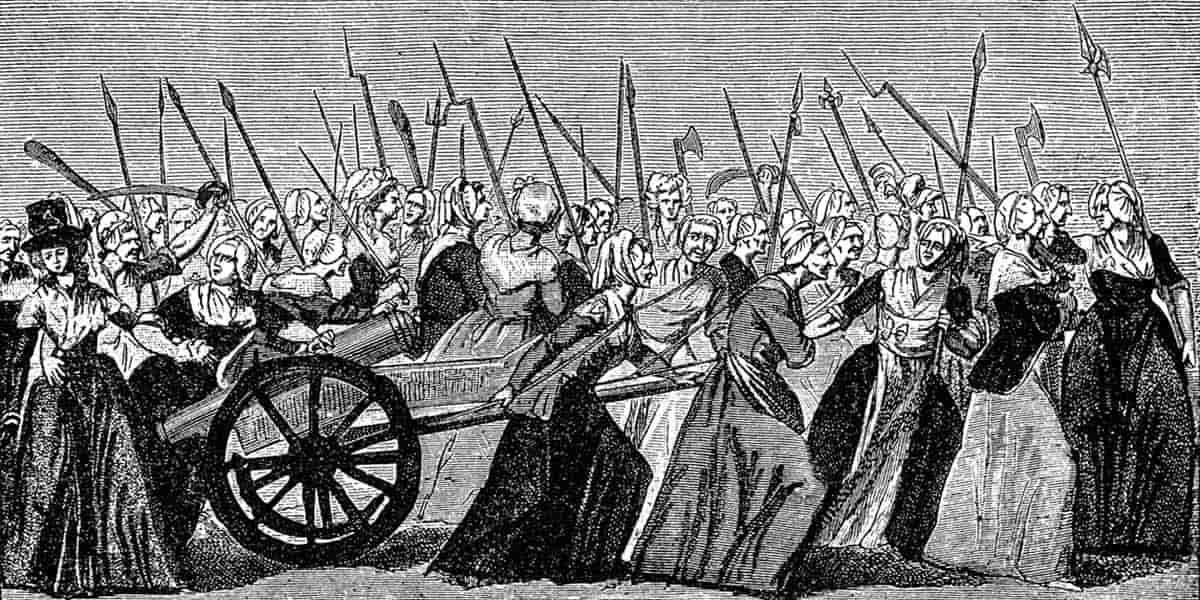The Women's March on Versailles

Give us this day our daily bread

The Women's March on Washington gets a lot of press buzz, but it's far from the first massive women's march for government action. On October 5, 1789, the women of Paris marched on Versailles with weapons and demands, and they changed the course of European history.
Why did they march?
A lot of readers will be familiar with the broad strokes of the French Revolution; the working class felt neglected by the aristocracy, and by the king in particular. Food was especially scarce. The price of bread (the staple food for most Parisians) was through the roof. But, politics then weren't any simpler than politics now. There was a bit more going on.
The monarchy of France was the most absolute in Europe. There was tight central control in many government affairs. The crown enforced strict regulations and business practices on behalf of the common people (as best they understood it). There were grain police who would make sure merchants weren't hoarding, and they would prevent grain exports from areas facing famine. They also maintained public stores.
In the decade before the Revolution, there was a big shift in the grain industry in France. The Controller-General of Finances, who was in charge of France's money, decided to rapidly deregulate. This sudden shift left the country ill-prepared for famine. When the grain harvest failed in Northeastern France, the country descended into chaos. Merchants speculated and hoarded grain and the police withheld public stores, causing widespread famine. After a violent uprising, the situation was resolved and the government fired the chief of police.
But, this affected how the peasants thought of the government. The poor people of Paris widely believed in a conspiracy theory that the aristocrats wanted to deliberately starve the poor. So, when there was another grain shortage in 1789, the common people were angry. And there was tension between reformers and royalists, based in Paris and Versailles respectively. The reformers called for a march, and the women of Paris answered.
Who marched?
Women, who were tasked with much of the domestic tasks like acquiring and preparing food, were especially put out by the food issues. While languishing in one of the city's marketplaces, a group of women began to organize. They rang a nearby church bell to call out supporters. Up to 10,000 people gathered, supported by sympathetic soldiers. They stormed the city hall of Paris, raided its food stores and emptied its armory. Those who couldn't get guns brought kitchen knives and other improvised weapons. This crowd, led in part by some of the people who stormed the Bastille, decided to bring their grievances to the King.
What did they march for?
The main thing they wanted was for the crown to ensure food safety for the poor. This meant fixing the broken grain industry, and releasing food stores to help fix bread prices. They walked for six hours from the center of the city to the palace beyond, dragging several cannons with them. When they got there, some of the women's leaders negotiated with the King to release grain from the stores, and they went home happy.
Most of the women stuck around. They decided that wasn't good enough. Now that they were at the palace gates, they decided to take more radical action. They besieged the palace until more of their demands were met. They even stormed a gate, killing two guards and threatening the queen. The King agreed to honor the Declaration of the Rights of Man, but even that wasn't enough. The final symbolic victory for the women came when the King agreed to return to the city proper; the court would no longer be seated outside of the reach of the common people.
What happened next?
This march set the stage for the rest of the Revolution. The court's move to Paris crippled their ability to resist the calls of reformers, and the first French Constitution was passed within two years. Maximilien Robespierre, who vocally supported the women, would go on to be the leader of the Revolution and the architect of the Terror. However one feels about the events of the Revolution, it's important to remember that the common women of Paris played an essential part.







